
- •About the Author
- •About the Technical Editor
- •Credits
- •Is This Book for You?
- •Software Versions
- •Conventions This Book Uses
- •What the Icons Mean
- •How This Book Is Organized
- •How to Use This Book
- •What’s on the Companion CD
- •What Is Excel Good For?
- •What’s New in Excel 2010?
- •Moving around a Worksheet
- •Introducing the Ribbon
- •Using Shortcut Menus
- •Customizing Your Quick Access Toolbar
- •Working with Dialog Boxes
- •Using the Task Pane
- •Creating Your First Excel Worksheet
- •Entering Text and Values into Your Worksheets
- •Entering Dates and Times into Your Worksheets
- •Modifying Cell Contents
- •Applying Number Formatting
- •Controlling the Worksheet View
- •Working with Rows and Columns
- •Understanding Cells and Ranges
- •Copying or Moving Ranges
- •Using Names to Work with Ranges
- •Adding Comments to Cells
- •What Is a Table?
- •Creating a Table
- •Changing the Look of a Table
- •Working with Tables
- •Getting to Know the Formatting Tools
- •Changing Text Alignment
- •Using Colors and Shading
- •Adding Borders and Lines
- •Adding a Background Image to a Worksheet
- •Using Named Styles for Easier Formatting
- •Understanding Document Themes
- •Creating a New Workbook
- •Opening an Existing Workbook
- •Saving a Workbook
- •Using AutoRecover
- •Specifying a Password
- •Organizing Your Files
- •Other Workbook Info Options
- •Closing Workbooks
- •Safeguarding Your Work
- •Excel File Compatibility
- •Exploring Excel Templates
- •Understanding Custom Excel Templates
- •Printing with One Click
- •Changing Your Page View
- •Adjusting Common Page Setup Settings
- •Adding a Header or Footer to Your Reports
- •Copying Page Setup Settings across Sheets
- •Preventing Certain Cells from Being Printed
- •Preventing Objects from Being Printed
- •Creating Custom Views of Your Worksheet
- •Understanding Formula Basics
- •Entering Formulas into Your Worksheets
- •Editing Formulas
- •Using Cell References in Formulas
- •Using Formulas in Tables
- •Correcting Common Formula Errors
- •Using Advanced Naming Techniques
- •Tips for Working with Formulas
- •A Few Words about Text
- •Text Functions
- •Advanced Text Formulas
- •Date-Related Worksheet Functions
- •Time-Related Functions
- •Basic Counting Formulas
- •Advanced Counting Formulas
- •Summing Formulas
- •Conditional Sums Using a Single Criterion
- •Conditional Sums Using Multiple Criteria
- •Introducing Lookup Formulas
- •Functions Relevant to Lookups
- •Basic Lookup Formulas
- •Specialized Lookup Formulas
- •The Time Value of Money
- •Loan Calculations
- •Investment Calculations
- •Depreciation Calculations
- •Understanding Array Formulas
- •Understanding the Dimensions of an Array
- •Naming Array Constants
- •Working with Array Formulas
- •Using Multicell Array Formulas
- •Using Single-Cell Array Formulas
- •Working with Multicell Array Formulas
- •What Is a Chart?
- •Understanding How Excel Handles Charts
- •Creating a Chart
- •Working with Charts
- •Understanding Chart Types
- •Learning More
- •Selecting Chart Elements
- •User Interface Choices for Modifying Chart Elements
- •Modifying the Chart Area
- •Modifying the Plot Area
- •Working with Chart Titles
- •Working with a Legend
- •Working with Gridlines
- •Modifying the Axes
- •Working with Data Series
- •Creating Chart Templates
- •Learning Some Chart-Making Tricks
- •About Conditional Formatting
- •Specifying Conditional Formatting
- •Conditional Formats That Use Graphics
- •Creating Formula-Based Rules
- •Working with Conditional Formats
- •Sparkline Types
- •Creating Sparklines
- •Customizing Sparklines
- •Specifying a Date Axis
- •Auto-Updating Sparklines
- •Displaying a Sparkline for a Dynamic Range
- •Using Shapes
- •Using SmartArt
- •Using WordArt
- •Working with Other Graphic Types
- •Using the Equation Editor
- •Customizing the Ribbon
- •About Number Formatting
- •Creating a Custom Number Format
- •Custom Number Format Examples
- •About Data Validation
- •Specifying Validation Criteria
- •Types of Validation Criteria You Can Apply
- •Creating a Drop-Down List
- •Using Formulas for Data Validation Rules
- •Understanding Cell References
- •Data Validation Formula Examples
- •Introducing Worksheet Outlines
- •Creating an Outline
- •Working with Outlines
- •Linking Workbooks
- •Creating External Reference Formulas
- •Working with External Reference Formulas
- •Consolidating Worksheets
- •Understanding the Different Web Formats
- •Opening an HTML File
- •Working with Hyperlinks
- •Using Web Queries
- •Other Internet-Related Features
- •Copying and Pasting
- •Copying from Excel to Word
- •Embedding Objects in a Worksheet
- •Using Excel on a Network
- •Understanding File Reservations
- •Sharing Workbooks
- •Tracking Workbook Changes
- •Types of Protection
- •Protecting a Worksheet
- •Protecting a Workbook
- •VB Project Protection
- •Related Topics
- •Using Excel Auditing Tools
- •Searching and Replacing
- •Spell Checking Your Worksheets
- •Using AutoCorrect
- •Understanding External Database Files
- •Importing Access Tables
- •Retrieving Data with Query: An Example
- •Working with Data Returned by Query
- •Using Query without the Wizard
- •Learning More about Query
- •About Pivot Tables
- •Creating a Pivot Table
- •More Pivot Table Examples
- •Learning More
- •Working with Non-Numeric Data
- •Grouping Pivot Table Items
- •Creating a Frequency Distribution
- •Filtering Pivot Tables with Slicers
- •Referencing Cells within a Pivot Table
- •Creating Pivot Charts
- •Another Pivot Table Example
- •Producing a Report with a Pivot Table
- •A What-If Example
- •Types of What-If Analyses
- •Manual What-If Analysis
- •Creating Data Tables
- •Using Scenario Manager
- •What-If Analysis, in Reverse
- •Single-Cell Goal Seeking
- •Introducing Solver
- •Solver Examples
- •Installing the Analysis ToolPak Add-in
- •Using the Analysis Tools
- •Introducing the Analysis ToolPak Tools
- •Introducing VBA Macros
- •Displaying the Developer Tab
- •About Macro Security
- •Saving Workbooks That Contain Macros
- •Two Types of VBA Macros
- •Creating VBA Macros
- •Learning More
- •Overview of VBA Functions
- •An Introductory Example
- •About Function Procedures
- •Executing Function Procedures
- •Function Procedure Arguments
- •Debugging Custom Functions
- •Inserting Custom Functions
- •Learning More
- •Why Create UserForms?
- •UserForm Alternatives
- •Creating UserForms: An Overview
- •A UserForm Example
- •Another UserForm Example
- •More on Creating UserForms
- •Learning More
- •Why Use Controls on a Worksheet?
- •Using Controls
- •Reviewing the Available ActiveX Controls
- •Understanding Events
- •Entering Event-Handler VBA Code
- •Using Workbook-Level Events
- •Working with Worksheet Events
- •Using Non-Object Events
- •Working with Ranges
- •Working with Workbooks
- •Working with Charts
- •VBA Speed Tips
- •What Is an Add-In?
- •Working with Add-Ins
- •Why Create Add-Ins?
- •Creating Add-Ins
- •An Add-In Example
- •System Requirements
- •Using the CD
- •What’s on the CD
- •Troubleshooting
- •The Excel Help System
- •Microsoft Technical Support
- •Internet Newsgroups
- •Internet Web sites
- •End-User License Agreement
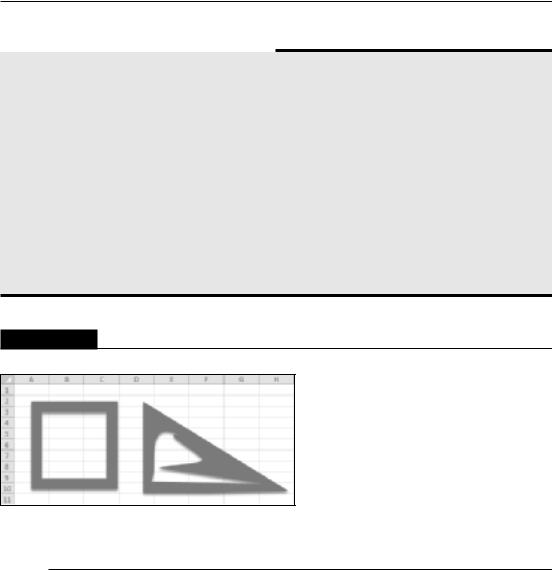
Chapter 22: Enhancing Your Work with Pictures and Drawings
Exporting Graphic Objects
If you create a graphic in Excel using Shapes, SmartArt, or WordArt, you may want to save the graphic as a separate file for use in another program. Unfortunately, Excel doesn’t provide a direct way to export a graphic, but here’s a trick you can use. Make sure that your graphic appears the way you want it and then follow these steps:
1.Save your workbook.
2.Choose File Save As to save your workbook as a Web Page. In the Save As dialog box, select Web Page (*.htm; *.html) from the Save as Type drop-down list.
3.Close the workbook.
4.Use Windows Explorer to locate the HTML file you saved in Step 2. You’ll notice that Excel also created a companion directory for the HTML file. If you save the file as myart.htm, the directory will be named myart_files.
5.Open the directory, and you’ll find *.png graphic files — one for each graphic object in your workbook. The *.png files have a transparent background.
FIGURE 22.6
A Shape, before and after editing its points.
Using SmartArt
Excel’s Shapes are certainly impressive, but the SmartArt feature is downright amazing. Using SmartArt, you can insert a wide variety of highly customizable diagrams into a worksheet, and you can change the overall look of the diagram with a few mouse clicks. This feature was introduced in Office 2007, and is probably more useful for PowerPoint users. But many Excel users will be able to make good use of SmartArt.
Inserting SmartArt
To insert SmartArt into a worksheet, choose Insert SmartArt. Excel displays the dialog box shown in Figure 22.7. The diagrams are arranged in categories along the left. When you find one
525
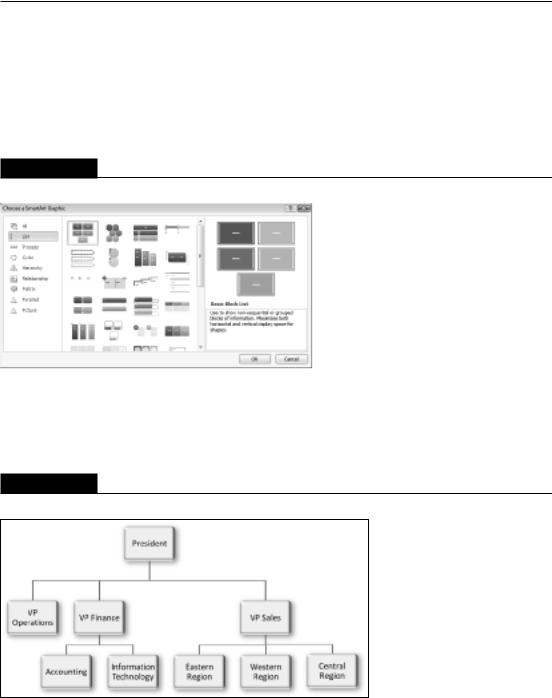
Part III: Creating Charts and Graphics
that looks appropriate, click it for a larger view in the panel on the right, which also provides some usage tips. Then click OK to insert the graphic.
Note
Don’t be concerned about the number of elements contained in the SmartArt graphics. You can customize the SmartArt to display the number of elements you need. n
FIGURE 22.7
Inserting a SmartArt graphic.
Figure 22.8 shows a SmartArt diagram after I customized it and added text. When you insert or select a SmartArt diagram, Excel displays its SmartArt Tools contextual tab, which provides many customization options.
FIGURE 22.8
This SmartArt shows a simple organizational chart.
526
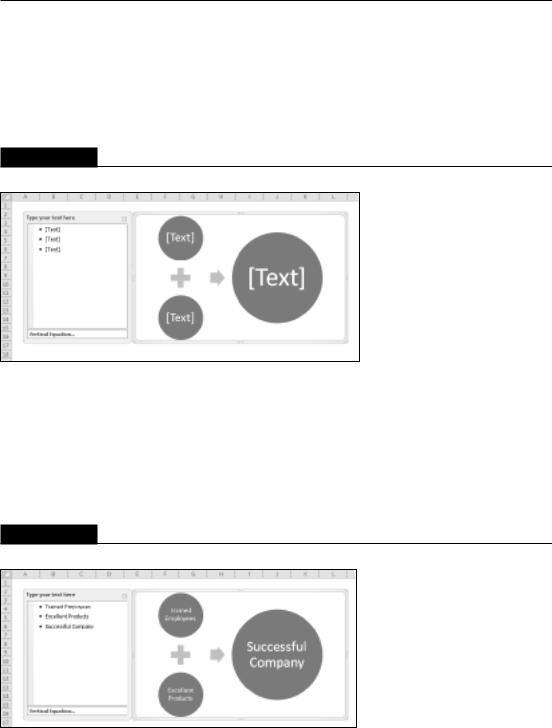
Chapter 22: Enhancing Your Work with Pictures and Drawings
Customizing SmartArt
Figure 22.9 shows a SmartArt graphic (named Vertical Equation, from the Process category) immediately after I inserted it into a worksheet. The Type Your Text Here window makes it very easy to enter text into the elements of the image. If you prefer, you can click one of the [Text] areas in the image and type the text directly.
FIGURE 22.9
This SmartArt needs to be customized.
Figure 22.10 shows the SmartArt after I added some text.
This particular diagram depicts two items combining into a third item. Suppose that your boss sees this graphic and tells you that you need a third item: Advanced Technology. To add an element to the SmartArt graphic, just select an item and choose SmartArt Tools Design Create Graphic Add Shape. Or you can just select an item and press Enter. Figure 22.11 shows the modified SmartArt.
FIGURE 22.10
The SmartArt now has text.
527
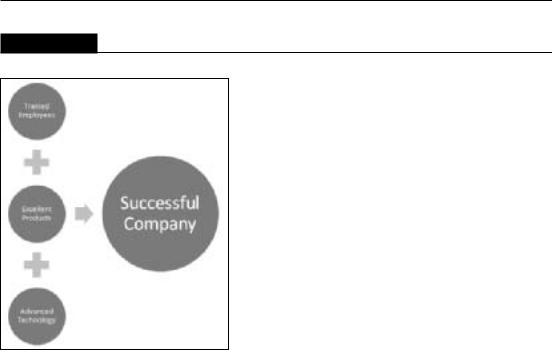
Part III: Creating Charts and Graphics
FIGURE 22.11
The SmartArt, after adding a new element.
When working with SmartArt, keep in mind that you can move, resize, or format individually any element within the graphic. Select the element and then use the tools on the SmartArt Tools Format tab.
Changing the layout
You can easily change the layout of a SmartArt diagram. Select the object and then choose SmartArt Tools Design Layouts. Any text that you’ve entered remains intact. Figure 22.12 shows a few alternate layouts for the previous example.
Changing the style
After you decide on a layout, you may want to consider other styles or colors available in the SmartArt Tools Design SmartArt Styles group. Figure 22.13 shows the diagram after I chose a different style and changed the colors.
Tip
SmartArt styles available vary depending upon the document theme assigned to the workbook. To change a workbook’s theme, choose Page Layout Themes Themes. Switching to a different theme can have a dramatic impact on the appearance of SmartArt diagrams. n
528
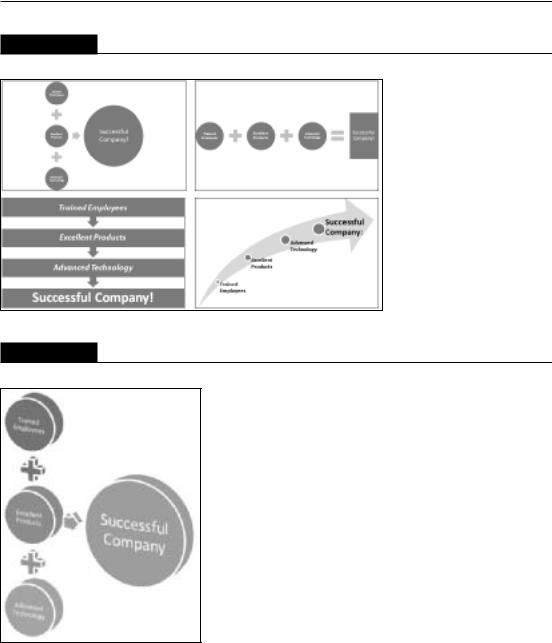
Chapter 22: Enhancing Your Work with Pictures and Drawings
FIGURE 22.12
A few different layouts for the SmartArt.
FIGURE 22.13
A few mouse clicks changed the style of this diagram.
Learning more about SmartArt
This section provided a basic introduction to SmartArt. The topic is complex enough to warrant an entire book, but I recommend simply experimenting with the commands.
529
